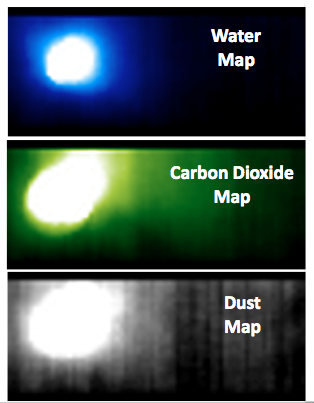EPOXI
Two intriguing investigations -- One flight-proven spacecraft
Gallery
A Fizzy Comet
Fig 1. Distribution maps of water, carbon dioxide, and dust around 103P/Hartley.
Fig 2. IR spectrum of 103P/Hartley showing the prominent water and carbon dioxide peaks.
Caption: Water and carbon dioxide dominate the infrared spectrum of comet Hartley 2's environment with organics like methanol also present. This is no surprise to scientists. What is surprising is that there is a lot more carbon dioxide escaping this comet than expected. The correlation between the asymmetric distribution of carbon dioxide and dust around the nucleus, which is much different than the isotropic water distribution, informs us that the carbon dioxide rather than water takes dust grains with it into the coma as it leaves the nucleus. For the first time, it is unambiguously shown that the sublimation of subsurface carbon dioxide, a volatile that has been preserved inside the comet since the formation of the solar system, drives the outgassing activity of a comet's nucleus. This spectrum and compositional maps of Hartley 2's coma were derived from data from the Deep Impact spacecraft when it was 44,000 kilometers away from the nucleus, 1 hour before it flew by.
The images were taken by EPOXI's High-Resolution Instrument Infrared Spectrometer (HRI-IR) on Nov. 4, 2010. The sun is to the right.
Credit: NASA/JPL-Caltech/UMD
Related Releases

 Click for larger image.
Click for larger image. Click for larger image.
Click for larger image.